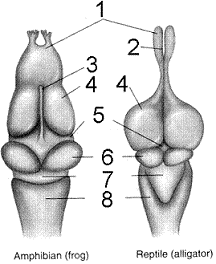The function of the structure labeled 4 in Figure 41-1 is to:
a. regulate respiration.
b. coordinate complex muscular activities.
c. interpret visual stimuli.
d. act as a relay center for motor and sensory messages.
e. integrate olfactory information.
E
You might also like to view...
The formation of amino acids under abiotic
conditions was important because they serve as a. a supply of structural units for proteins. b. enzymes to catalyze reactions. c. subunits in the formation of DNA. d. subunits in the formation of RNA. e. subunits for the formation of lipids
Imagine you were ‘building’ a plant. You wanted a particular tissue to be somewhat rigid but capable
of rapid growth. What tissue type would you pick? What will be an ideal response?
Intestinal cells absorb glucose via active transport. What would happen if all the mitochondria within these intestinal cells were destroyed?
a. Glucose absorption would increase b. Glucose absorption would decrease c. Glucose absorption would stop d. Glucose absorption would stop
Given the parents AABBCc × AabbCc, assume simple dominance for each trait and independent assortment. What proportion of the progeny will be expected to phenotypically resemble the first parent with genotype AABBCc?
A) 1/4 B) 3/4 C) 3/8 D) 1